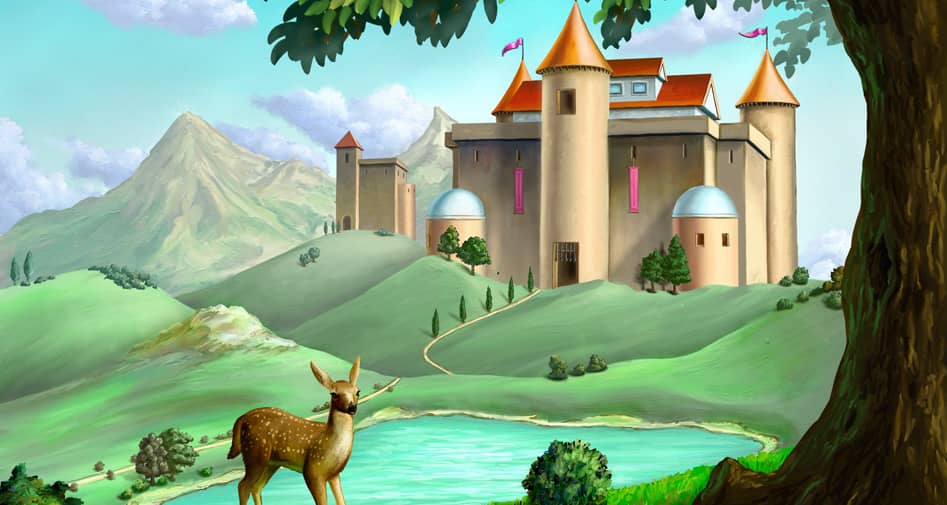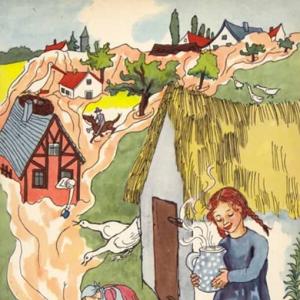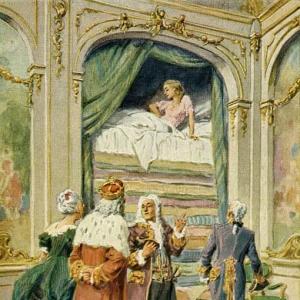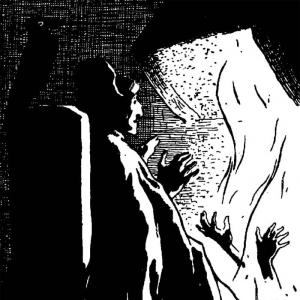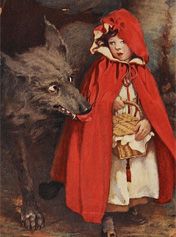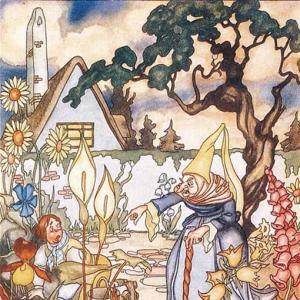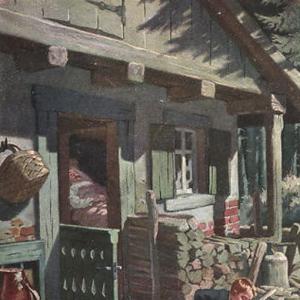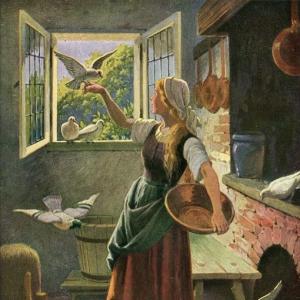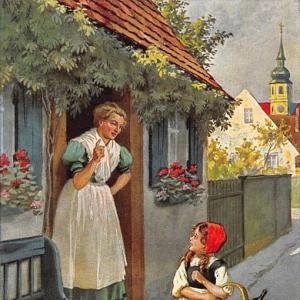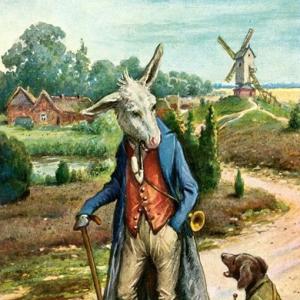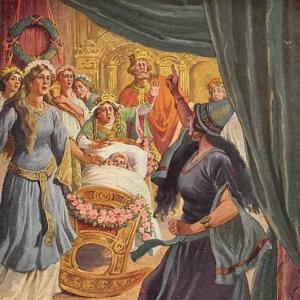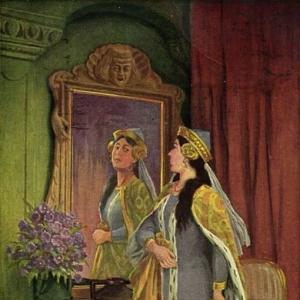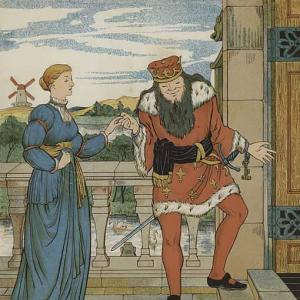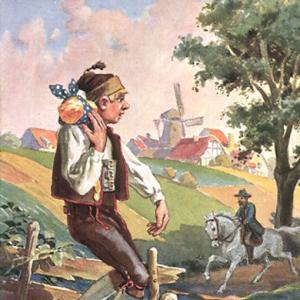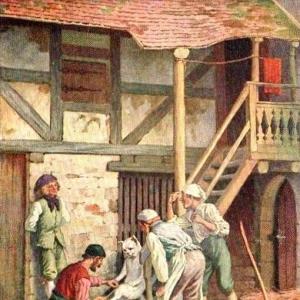Reading time for children: 12 min
There was once a regular student, who lived in a garret, and had no possessions. And there was also a regular huckster, to whom the house belonged, and who occupied the ground floor. A goblin lived with the huckster, because at Christmas he always had a large dish full of jam, with a great piece of butter in the middle. The huckster could afford this; and therefore the goblin remained with the huckster, which was very cunning of him.
One evening the student came into the shop through the back door to buy candles and cheese for himself, he had no one to send, and therefore he came himself. He obtained what he wished, and then the huckster and his wife nodded good evening to him, and she was a woman who could do more than merely nod, for she had usually plenty to say for herself. The student nodded in return as he turned to leave, then suddenly stopped, and began reading the piece of paper in which the cheese was wrapped. It was a leaf torn out of an old book, a book that ought not to have been torn up, for it was full of poetry.
„Yonder lies some more of the same sort,“ said the huckster: „I gave an old woman a few coffee berries for it. You shall have the rest for sixpence, if you will.“
„Indeed I will,“ said the student; „give me the book instead of the cheese. I can eat my bread and butter without cheese. It would be a sin to tear up a book like this. You are a clever man; and a practical man; but you understand no more about poetry than that cask yonder.“
This was a very rude speech, especially against the cask; but the huckster and the student both laughed, for it was only said in fun. But the goblin felt very angry that any man should venture to say such things to a huckster who was a householder and sold the best butter. As soon as it was night, and the shop closed, and every one in bed except the student, the goblin stepped softly into the bedroom where the huckster’s wife slept, and took away her tongue, which of course, she did not then want. Whatever object in the room he placed his tongue upon immediately received voice and speech, and was able to express its thoughts and feelings as readily as the lady herself could do. It could only be used by one object at a time, which was a good thing, as a number speaking at once would have caused great confusion. The goblin laid the tongue upon the cask, in which lay a quantity of old newspapers.
„Is it really true,“ he asked, „that you do not know what poetry is?“
„Of course I know,“ replied the cask: „poetry is something that always stand in the corner of a newspaper, and is sometimes cut out; and I may venture to affirm that I have more of it in me than the student has, and I am only a poor tub of the huckster’s.“
Then the goblin placed the tongue on the coffee mill; and how it did go to be sure! Then he put it on the butter tub and the cash box, and they all expressed the same opinion as the waste-paper tub; and a majority must always be respected.
„Now I shall go and tell the student,“ said the goblin; and with these words he went quietly up the back stairs to the garret where the student lived. He had a candle burning still, and the goblin peeped through the keyhole and saw that he was reading in the torn book, which he had brought out of the shop. But how light the room was! From the book shot forth a ray of light which grew broad and full, like the stem of a tree, from which bright rays spread upward and over the student’s head. Each leaf was fresh, and each flower was like a beautiful female head. Some with dark and sparkling eyes, and others with eyes that were wonderfully blue and clear. The fruit gleamed like stars, and the room was filled with sounds of beautiful music. The little goblin had never imagined, much less seen or heard of, any sight so glorious as this. He stood still on tiptoe, peeping in, till the light went out in the garret. The student no doubt had blown out his candle and gone to bed; but the little goblin remained standing there nevertheless, and listening to the music which still sounded on, soft and beautiful, a sweet cradle-song for the student, who had lain down to rest.
„This is a wonderful place,“ said the goblin; „I never expected such a thing. I should like to stay here with the student;“ and the little man thought it over, for he was a sensible little spirit. At last he sighed, „but the student has no jam!“ So he went down stairs again into the huckster’s shop, and it was a good thing he got back when he did, for the cask had almost worn out the lady’s tongue. He had given a description of all that he contained on one side, and was just about to turn himself over to the other side to describe what was there, when the goblin entered and restored the tongue to the lady. But from that time forward, the whole shop, from the cash box down to the pinewood logs, formed their opinions from that of the cask; and they all had such confidence in him, and treated him with so much respect, that when the huckster read the criticisms on theatricals and art of an evening, they fancied it must all come from the cask.
But after what he had seen, the goblin could no longer sit and listen quietly to the wisdom and understanding down stairs; so, as soon as the evening light glimmered in the garret, he took courage, for it seemed to him as if the rays of light were strong cables, drawing him up, and obliging him to go and peep through the keyhole; and, while there, a feeling of vastness came over him such as we experience by the ever-moving sea, when the storm breaks forth; and it brought tears into his eyes. He did not himself know why he wept, yet a kind of pleasant feeling mingled with his tears. „How wonderfully glorious it would be to sit with the student under such a tree;“ but that was out of the question, he must be content to look through the keyhole, and be thankful for even that.
There he stood on the old landing, with the autumn wind blowing down upon him through the trap-door. It was very cold; but the little creature did not really feel it, till the light in the garret went out, and the tones of music died away. Then how he shivered, and crept down stairs again to his warm corner, where it felt home-like and comfortable. And when Christmas came again, and brought the dish of jam and the great lump of butter, he liked the huckster best of all.
Soon after, in the middle of the night, the goblin was awoke by a terrible noise and knocking against the window shutters and the house doors, and by the sound of the watchman’s horn. For a great fire had broken out, and the whole street appeared full of flames. Was it in their house, or a neighbor’s? No one could tell, for terror had seized upon all. The huckster’s wife was so bewildered that she took her gold ear-rings out of her ears and put them in her pocket, that she might save something at least. The huckster ran to get his business papers, and the servant resolved to save her blue silk mantle, which she had managed to buy. Each wished to keep the best things they had. The goblin had the same wish; for, with one spring, he was up stairs and in the student’s room, whom he found standing by the open window, and looking quite calmly at the fire, which was raging at the house of a neighbor opposite. The goblin caught up the wonderful book which lay on the table, and popped it into his red cap, which he held tightly with both hands. The greatest treasure in the house was saved; and he ran away with it to the roof, and seated himself on the chimney. The flames of the burning house opposite illuminated him as he sat, both hands pressed tightly over his cap, in which the treasure lay; and then he found out what feelings really reigned in his heart, and knew exactly which way they tended. And yet, when the fire was extinguished, and the goblin again began to reflect, he hesitated, and said at last, „I must divide myself between the two. I cannot quite give up the huckster, because of the jam.“
And this is a representation of human nature. We are like the goblin. We all go to visit the huckster „because of the jam.“
 Learn languages. Double-tap on a word.Learn languages in context with Childstories.org and Deepl.com.
Learn languages. Double-tap on a word.Learn languages in context with Childstories.org and Deepl.com.Backgrounds
Interpretations
Adaptions
Summary
Linguistics
„The Goblin and the Huckster“ is a fairy tale written by Danish author Hans Christian Andersen, who is best known for his timeless stories such as „The Little Mermaid,“ „The Ugly Duckling,“ and „The Emperor’s New Clothes.“ Born in 1805 in Odense, Denmark, Andersen grew up in a poor family, but his talent for storytelling led him to become one of the most renowned authors of his time.
Andersen’s fairy tales are known for their blend of magic, fantasy, and moral lessons, often addressing universal themes that resonate with readers of all ages. His stories have been translated into numerous languages and have been adapted into various forms of media, such as plays, films, and ballets.
„The Goblin and the Huckster“ was first published in 1861 as part of a collection titled „New Fairy Tales. First Volume. Third Collection“ (Nye Eventyr. Første Bind. Tredie Samling). Like many of Andersen’s tales, this story explores themes such as the value of art and culture, materialism, and the human condition. Through the character of the goblin, the story illustrates the struggle between the pursuit of intellectual and spiritual fulfillment and the desire for material comforts, a struggle that is relevant to readers even today.
„The Goblin and the Huckster“ can be interpreted on various levels, touching upon themes such as the value of art and poetry, materialism, and the human condition.
The value of art and poetry: The story highlights the power of poetry to elevate the human spirit, as seen in the student’s room, which is transformed by the poetry book into a space of beauty, light, and music. It also emphasizes the importance of preserving art and culture, as the student chooses to save the book of poetry instead of buying cheese.
Materialism: The huckster and his wife, along with the objects in their shop, represent a materialistic view of the world, where material comforts such as jam take precedence over intellectual and artistic pursuits. The goblin, too, finds it hard to resist the allure of material comforts, ultimately choosing to stay with the huckster for the jam.
The human condition: The goblin’s struggle to choose between the intellectual and spiritual fulfillment offered by the student and the material comforts provided by the huckster mirrors the choices humans face in their lives. This theme is illustrated by the story’s closing lines, which state that humans are like the goblin, visiting the huckster „because of the jam.“ This suggests that people often prioritize material gains and comforts over intellectual and spiritual enrichment.
The transformative power of art: The story also demonstrates how exposure to art and beauty can change a person’s perspective. The goblin, initially dismissive of the student and poetry, becomes deeply moved after witnessing the magical scenes in the student’s room, leading him to value the poetry book as a precious treasure.
Overall, „The Goblin and the Huckster“ presents a reflection on the choices we make in life, the value of art and poetry, and the human tendency to prioritize material possessions and comforts over intellectual and spiritual growth.
„The Goblin and the Huckster“ by Hans Christian Andersen has inspired several adaptations in various forms of media. Here are a few examples.
Theater: In 2018, the National Theater of Greece performed a play based on „The Goblin and the Huckster.“ The play, titled „The Huckster and the Goblin,“ was a modern retelling of the story that explored themes of consumerism and greed in contemporary society.
Short Film: In 2021, a short film adaptation of „The Goblin and the Huckster“ was released on YouTube. The film, directed by Josiah Friesen, reimagines the story as a horror film, with the goblin as a sinister figure that preys on the huckster’s greed and desire for power.
Children’s Book: In 2013, author and illustrator Sophie Burrows published a children’s book adaptation of „The Goblin and the Huckster.“ The book, titled „The Magic Peddler,“ features colorful illustrations and simplified language, making it accessible to young readers.
Opera: In 1982, the composer Per Nørgård premiered his opera „The Divine Circus,“ which was based on „The Goblin and the Huckster“ and other tales by Hans Christian Andersen. The opera is a dark, surreal work that explores themes of innocence, corruption, and the struggle between good and evil.
Overall, „The Goblin and the Huckster“ has proven to be a rich source of inspiration for artists and storytellers in various media, each adapting the story in their own unique way to reflect their own perspectives and visions.
„The Goblin and the Huckster“ is a fairy tale by Hans Christian Andersen that tells the story of a cunning goblin who lives with a huckster and his wife. The huckster owns a shop on the ground floor of a house, while a student lives in a garret above.
One evening, the student visits the shop to buy candles and cheese. While there, he discovers a piece of poetry on the paper wrapping the cheese. The huckster offers to sell him a book full of poetry for sixpence, and the student agrees, leaving the cheese behind. Later that night, the goblin, feeling angry at the student’s earlier comment that the huckster knows nothing about poetry, takes the huckster’s wife’s tongue and grants the ability to speak to various objects in the room. They all agree that they understand poetry better than the student.
Curious, the goblin visits the student’s room and peeps through the keyhole to find him reading the poetry book. The room is filled with light, beautiful visions, and music, which deeply affects the goblin. He wishes to stay with the student but decides against it as the student has no jam, which the huckster does.
Later, a fire breaks out in a nearby house, and everyone rushes to save their most prized possessions. The goblin saves the poetry book and realizes that it is the most valuable thing in the house. He considers staying with the student but ultimately decides to remain with the huckster because of the jam, symbolizing the human tendency to choose material comforts over intellectual and spiritual pursuits.
Hans Christian Andersen’s fairy tale „The Goblin and the Huckster“ is a rich text for linguistic analysis, offering insights into themes, character development, and the use of language. Here are some aspects of the story from a linguistic perspective:
Characterization through Dialogue and Diction: The characters are defined by their speech and actions. The student’s dialogue indicates a love for literature and a disdain for materialism, as evidenced by his choice of the book over cheese. His manner of speaking is formal and respectful, yet playful, showing his intellectual superiority and kindness. The huckster, by contrast, is portrayed as practical and materialistic. The use of the phrase „a clever man; and a practical man“ underscores his straightforward, utilitarian nature. The goblin’s speech and actions highlight his internal conflict and curiosity. He is driven by both material desires (jam) and a newfound appreciation for the abstract beauty of poetry.
Narrative Voice and Style: Andersen employs a narrative style that is both whimsical and gently satirical. The narrative voice provides a critical yet humorous perspective on human nature, as seen in the concluding lines. The use of phrases like „a representation of human nature“ suggests a moral lesson typical of fairy tales. The language used to describe the magical transformation when the student reads the book is vivid and metaphorical, contrasting starkly with the mundane setting of the huckster’s shop. This highlights the transformative power of literature and art.
Symbolism and Metaphor: The goblin, a supernatural being, serves as a metaphor for the duality of human desires: the tension between material comfort and intellectual or spiritual fulfillment. His physical antics and literal juggling of responsibilities symbolize this inner conflict. Objects in the story, like the „cask“ and „cash box,“ are anthropomorphized, providing a satirical commentary on materialism. The book, which emits light and music, represents enlightenment and the beauty of intellectual pursuits, contrasted with the materialistic setting of the huckster’s world.
Themes Highlighted Through Language
Materialism vs. Intellectualism: The narrative contrasts the tangible rewards of the huckster’s world with the intangible joy and enlightenment found in the student’s book.
Curiosity and Growth: The goblin’s journey from contempt for the student’s values to appreciation signifies learning and personal growth, facilitated by exposure to art and literature.
Human Nature and Choice: The goblin’s indecision reflects the broader human condition, caught between physical needs and higher aspirations. Andersen uses simple, accessible language to explore complex philosophical issues.
Moral and Philosophical Implications: The story closes with a moral reflection on human nature’s tendency to prioritize material comforts („the jam“) over intellectual or spiritual pursuits. This critique is cleverly woven into the fabric of a fairy tale, making it accessible yet profound.
In summary, „The Goblin and the Huckster“ showcases Andersen’s ability to use language not only to entertain but also to provoke thought about deeper philosophical and moral questions. Through character interactions, descriptive language, and symbolic elements, Andersen crafts a narrative that is both a whimsical fairy tale and a poignant reflection on humanity.
Information for scientific analysis
Fairy tale statistics | Value |
|---|---|
| Translations | DE, EN, DA, ES, IT, NL |
| Readability Index by Björnsson | 37.6 |
| Flesch-Reading-Ease Index | 73.2 |
| Flesch–Kincaid Grade-Level | 9.1 |
| Gunning Fog Index | 11.6 |
| Coleman–Liau Index | 8.3 |
| SMOG Index | 9.2 |
| Automated Readability Index | 10.1 |
| Character Count | 8.131 |
| Letter Count | 6.311 |
| Sentence Count | 63 |
| Word Count | 1.542 |
| Average Words per Sentence | 24,48 |
| Words with more than 6 letters | 202 |
| Percentage of long words | 13.1% |
| Number of Syllables | 1.983 |
| Average Syllables per Word | 1,29 |
| Words with three Syllables | 68 |
| Percentage Words with three Syllables | 4.4% |
